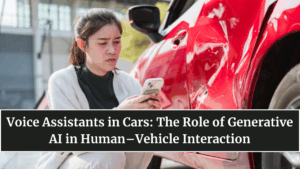The year 2025 marks a turning point in automotive technology. Cars are no longer just machines — they are intelligent companions. At the heart of this transformation lies the evolution of voice assistants in cars, powered by generative AI. These assistants are redefining how drivers interact with their vehicles, turning simple voice commands into intelligent, conversational experiences that anticipate needs and personalize every journey.
From adjusting temperature and navigation to learning a driver’s mood, the new generation of AI-powered systems is transforming vehicles into smart, responsive co-drivers — ones that talk, learn, and adapt like humans.

The Evolution from Basic Commands to Generative Conversations
Early in-car voice assistants were limited to simple instructions like “play music” or “call home.” But thanks to breakthroughs in natural language processing (NLP) and generative AI, these systems can now hold human-like conversations, understand context, and even detect emotion.
Modern assistants like Mercedes-Benz MBUX, BMW’s Intelligent Personal Assistant, and Google’s Android Auto AI have become far more capable — they can now interpret vague commands such as:
-
“I’m feeling cold,” to adjust cabin temperature automatically.
-
“Find me a quiet café on my route,” to use real-time data and preferences.
-
“I’m tired,” to suggest rest stops or switch to relaxing music.
These interactions go beyond command recognition — they embody personalized communication, making each drive smoother and more intuitive.
How Generative AI Enhances In-Car Interaction
Generative AI enables the car to generate dynamic responses rather than relying on pre-programmed replies. The system uses deep learning models trained on massive datasets of human speech, tone, and behavior to produce natural, context-aware dialogue.
Key improvements include:
-
Context Awareness: Understanding what you mean, not just what you say.
-
Emotional Intelligence: Adjusting tone, lighting, and music based on driver mood.
-
Continuous Learning: Remembering habits such as preferred routes or seating positions.
-
Multimodal Integration: Combining speech with gestures, eye movement, or facial expressions.
This fusion of AI and voice control allows cars to anticipate needs — for example, lowering windows if air quality drops, or offering directions to charging stations when the EV’s battery is low.
Safety and Convenience: The Core Benefits
One of the biggest advantages of AI-powered voice assistants is safety. By allowing drivers to control multiple systems hands-free, they minimize distraction and enhance focus on the road.
Major benefits include:
-
Hands-Free Operation: Reduce distractions while navigating or changing settings.
-
Smart Navigation: Provide traffic updates and rerouting options verbally.
-
Proactive Alerts: Notify about weather conditions or road hazards.
-
Driver Health Monitoring: Integrated with sensors to detect drowsiness or stress levels.
As regulations around driver distraction tighten globally, automakers are increasingly using AI voice control as a compliant and safe interface for digital interaction.
Integration with Vehicle Ecosystems
Today’s in-car voice assistants are deeply embedded into connected vehicle ecosystems. They work seamlessly with infotainment systems, IoT devices, and even smart home networks.
For example:
-
You can say, “Turn off my home lights,” as you drive away.
-
“Send my ETA to office” will automatically text your contacts.
-
“Schedule service appointment” connects directly to the manufacturer’s maintenance system.
This level of ecosystem integration creates a fluid digital experience across personal and professional spaces. Your car becomes an extension of your connected lifestyle.
The Role of Major Tech and Auto Giants
Automotive manufacturers and tech giants are racing to dominate the AI voice ecosystem.
-
Apple’s CarPlay with Siri 2.0 now uses on-device AI to process speech locally, preserving privacy.
-
Google’s Assistant in Android Automotive integrates with Maps, Calendar, and even EV charging networks.
-
Amazon Alexa Auto is expanding its partnerships with EV brands for smart energy and home integration.
-
Startups like SoundHound and Cerence are introducing domain-specific generative models for automotive use, offering more accurate context interpretation.
This collaboration between carmakers and tech innovators ensures that every voice command feels seamless, natural, and responsive.
Challenges in Adopting Generative AI in Cars
Despite its promise, the integration of generative AI comes with challenges:
-
Data Privacy: Cars collect sensitive speech and behavioral data.
-
Connectivity Limitations: Cloud-based models require stable internet.
-
Cost & Hardware: Running AI locally demands powerful processors and storage.
-
Regional Language Support: Expanding capabilities to local dialects is still in progress.
To address these, companies are now using edge AI — processing voice data directly inside the vehicle — to ensure privacy, low latency, and offline functionality.
The Future: Conversational Cars That Think Like Humans
By 2030, in-car voice assistants will evolve into emotionally intelligent copilots. They’ll understand not just commands but intentions and emotions, personalizing experiences in real time. Expect features like:
-
Conversational route planning that adapts to preferences.
-
Adaptive voice modulation for comfort and clarity.
-
Human-like empathy, offering reassurance during stress or fatigue.
-
Generative entertainment, narrating news, stories, or reminders on demand.
Cars of the near future won’t just listen — they’ll talk, empathize, and assist, making every drive a partnership between human and machine.
FAQs
What are AI voice assistants in cars?
They are AI-powered systems that enable hands-free communication with the car, controlling features and providing information through voice interaction.
How does generative AI improve these assistants?
It allows natural, context-aware conversations and personalizes responses based on user behavior and preferences.
Can voice assistants work without internet?
Yes, newer systems with edge AI can process speech locally, enabling offline commands and faster responses.
Which car brands use AI voice assistants?
Brands like Tesla, Mercedes, BMW, Hyundai, and Volvo have integrated advanced AI-based assistants in their latest models.
Will voice assistants replace traditional controls?
Not entirely, but they will become the primary interface for most car functions, offering safer and more intuitive driving experiences.
Click here to know more.
